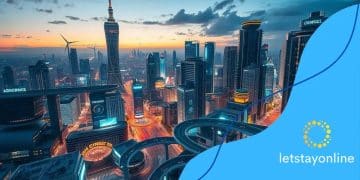Water scarcity solutions being implemented in urban areas

Water scarcity solutions being implemented in urban areas involve innovative technologies, community-driven initiatives, and effective government policies aimed at conserving resources and ensuring sustainable water management for future generations.
Water scarcity solutions being implemented in urban areas are becoming increasingly important as cities face growing demands on fresh water. What strategies are cities adopting to ensure access to this vital resource? Let’s dive in!
Understanding urban water scarcity
Understanding urban water scarcity is essential as cities continue to grow and face increasing pressure on their water resources. Urban areas struggle with limited water supplies while accommodating rising populations. This challenge raises questions about how we can manage our water effectively.
Causes of Water Scarcity
Several factors contribute to urban water scarcity. One significant cause is the growing population in cities, which intensifies the demand for water. Additionally, climate change has led to unpredictable weather patterns, affecting water availability. Pollution of water sources, along with outdated infrastructure, also plays a critical role in exacerbating this issue.
Impact on Communities
Water scarcity can deeply affect communities in urban areas. When access to clean water is limited, health risks increase, particularly for vulnerable populations. Economic impacts are also significant; industries rely on water for operations, and shortages can hinder growth. To address these challenges, urban planners and policymakers must implement effective strategies.
- Investing in water-efficient technologies
- Enhancing water recycling programs
- Implementing rainwater harvesting systems
By understanding these impacts, communities can become better equipped to address the challenges of water scarcity. Education and awareness are crucial. Residents must be informed about the importance of conserving water and the methods available to do so.
Overall, tackling the issue of urban water scarcity requires a multifaceted approach. Collaboration between government, community groups, and businesses can lead to innovative solutions. As cities grow, prioritizing sustainable water management will be necessary to ensure future generations have access to this vital resource.
Innovative technologies for water recycling
Innovative technologies for water recycling are essential in addressing urban water scarcity. These technologies help cities conserve water while ensuring a sustainable supply. As urban areas grow, adopting these techniques becomes increasingly important.
Advanced Filtration Systems
One significant advancement in water recycling is the development of advanced filtration systems. These systems utilize various methods, including membrane filtration, to remove contaminants efficiently. By ensuring high-quality recycled water, cities can safely reuse resources for irrigation and industrial processes.
Biological Treatment Methods
Another innovative technology includes biological treatment methods, which use microorganisms to break down organic waste in water. This process can greatly increase the sustainability of water recycling efforts. Constructed wetlands are a popular example, providing natural filtration while creating green spaces in urban environments.
- Membrane bioreactors combining filtration and biological treatment
- Innovative decentralized systems for small communities
- Smart sensors for real-time monitoring and management
Water recycling not only addresses scarcity but can also enhance urban resilience. By integrating these technologies, cities can build a more sustainable future. The use of reclaimed water for landscaping and toilet flushing are practical applications that showcase the benefits of these innovations.
Furthermore, public acceptance is crucial for promoting water recycling initiatives. Educating the community about the safety and benefits of using recycled water can encourage more widespread adoption. With effective communication and the right technologies, cities can significantly reduce their dependence on freshwater sources.
Community-driven solutions for water conservation

Community-driven solutions for water conservation are vital in addressing urban water scarcity. These solutions empower local residents to take an active role in managing their water resources. By working together, communities can implement effective strategies tailored to their unique needs.
Grassroots Initiatives
Grassroots initiatives often start with local organizations rallying community members around conservation efforts. These initiatives can include educational programs that teach residents about water-saving techniques. Engaging community members fosters a sense of ownership and responsibility for local water resources.
Collaborative Projects
Collaborative projects, like community gardens, play a crucial role in conserving water while benefiting residents. These projects can utilize rainwater harvesting systems to collect and use rainwater for irrigation. By sharing resources, neighborhoods can reduce overall water usage and promote biodiversity.
- Organizing clean-up campaigns for local water bodies
- Promoting water-efficient appliances and fixtures
- Creating awareness about local water quality issues
Additionally, community-driven solutions often include advocating for policy changes. Residents can work together to petition local governments for sustainable water management practices that prioritize conservation. When individuals unite, their collective voice can lead to significant changes.
Through community engagement, sharing knowledge, and taking action, these solutions not only address water scarcity but also build stronger, more resilient neighborhoods. Support from local businesses can further enhance these initiatives, creating partnerships that foster innovation in water conservation.
Government policies addressing water scarcity
Government policies addressing water scarcity are crucial for ensuring sustainable management of water resources. These policies help establish guidelines and frameworks to protect water availability for future generations. They also encourage efficient use and conservation among residents and industries.
Regulations and Standards
One key aspect of effective water management is implementing regulations and standards. Governments can set limits on water extraction from natural sources and enforce penalties for exceeding those limits. These regulations help maintain the balance needed to protect ecosystems and ensure reliable water supplies.
Public Funding and Support
Another important policy is the allocation of public funds for water conservation projects. Investing in infrastructure improvements and new technologies can significantly enhance water efficiency. Such initiatives can include upgrading old pipes and installing smarter water meters that track consumption.
- Implementing incentives for water-efficient appliances
- Supporting community education programs about conservation
- Promoting sustainable agricultural practices
Furthermore, collaboration between local governments and communities is vital. By engaging citizens, policymakers can better understand the challenges they face regarding water availability. This collaboration can lead to more tailored solutions that reflect local needs.
Effective government policies also address the impacts of climate change on water resources. Countries can develop comprehensive plans that incorporate climate adaptation strategies into their water management practices. This can involve enhancing storage capabilities during wet seasons, improving irrigation methods, and utilizing recycled water in agriculture.
Case studies of successful urban initiatives
Case studies of successful urban initiatives offer valuable insights into effective water scarcity solutions. These examples illustrate how cities around the world are tackling water challenges through innovative approaches and community involvement. Learning from these initiatives can guide other urban areas in their quest for sustainable water management.
Smart Water Management in Singapore
One prominent example is Singapore’s smart water management system. The city-state has invested in advanced technologies to monitor water usage and detect leaks. By implementing a comprehensive network of sensors and data analytics, Singapore has managed to reduce its water wastage significantly. This initiative has enabled them to maximize their limited water resources.
Los Angeles’ Water Conservation Programs
Another successful case is Los Angeles, which has launched various water conservation programs. These programs encourage residents to adopt water-saving practices through incentives for installing efficient appliances. Furthermore, the city has transformed underutilized spaces into sustainable green areas that promote rainwater absorption and reduce runoff.
- Programs offering rebates for turf replacement
- Rain barrel distribution to homeowners
- Workshops on xeriscaping and drought-resistant plants
Community engagement has played a crucial role in LA’s success. Residents participate actively in local awareness campaigns, leading to a shared commitment to water conservation. Collaborative efforts among communities, businesses, and the local government amplify the impact of these initiatives.
In Melbourne, Australia, the city has implemented the “Water Smart” program, which focuses on enhancing water efficiency in local households and businesses. By promoting graywater recycling and sustainable landscaping, Melbourne aims to reduce its reliance on imported water. This initiative not only conserves water but also prepares the city for potential drought conditions.
FAQ – Frequently Asked Questions about Urban Water Scarcity Solutions
What are some effective methods for conserving water in urban areas?
Effective methods include installing water-efficient fixtures, implementing rainwater harvesting systems, and promoting xeriscaping to reduce irrigation needs.
How can community initiatives help with water conservation?
Community initiatives engage residents in conservation efforts, such as organizing clean-up campaigns, educational workshops, and promoting water-saving practices at home.
What role does government policy play in addressing water scarcity?
Government policies create regulations and provide funding for conservation projects, encouraging sustainable practices and supporting infrastructure improvements.
Why are case studies important for understanding water management?
Case studies illustrate real-world solutions and successful initiatives, providing valuable insights for other cities facing similar water challenges.






